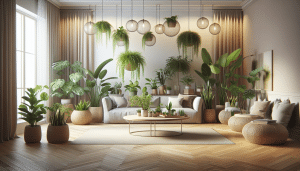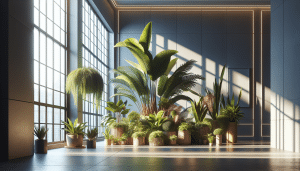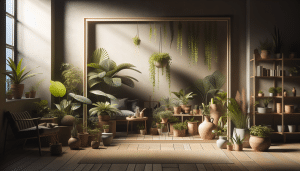Smart Ways You Can Transform Your Outdoor Space
Daniel Fisher September 17, 2025
Curious about giving your backyard a fresh look? Discover simple landscaping, DIY garden upgrades, patio ideas, and sustainable gardening tips to help you reimagine outdoor living. This article guides you through creative, budget-friendly solutions for every size yard, making your outdoor space more functional and enjoyable.
Landscaping Inspiration for Modern Outdoor Areas
Landscaping isn’t just about planting a few flowers—it’s about creating a cohesive, enjoyable environment that welcomes outdoor living. Modern landscaping blends form and function, offering striking visual appeal while keeping maintenance manageable. Many homeowners start by evaluating the amount of sunlight, slope, and existing greenery. Designing for your microclimate can help plants thrive and cut down on watering needs. Incorporating pathways, well-placed shrubs, and easy-care perennials adds character. This approach lets you personalize your yard while remaining practical and eco-conscious. Strategic use of mulch and native plants can instantly uplift curb appeal and reduce weed growth without constant intervention.
Creative landscaping needn’t require a full overhaul or high expense. A popular trend involves adding layers—using low groundcovers, medium shrubs, and taller trees to build depth and interest. Feature plants like ornamental grasses, hostas, or Japanese maples introduce color and texture. For those who prefer minimalism, structured hedges and geometric beds add a sense of order and harmony. Including small seating zones or benches throughout the landscape encourages exploration and enjoyment. Balancing hardscape elements such as stones, gravel, or wooden edging with lush greenery helps maintain a low-maintenance yet inviting look for visitors and residents alike.
Homeowners sometimes overlook the power of focal points in landscape design. Adding a small pond, a sculptural planter, or a brightly colored birdbath can turn an ordinary yard into an eye-catching retreat. The placement of these features draws the eye, while lighting—such as solar or low-voltage fixtures—extends usability after sunset. Edible landscapes, where herbs and vegetables are integrated into decorative beds, are gaining popularity. This dual-purpose gardening makes fresh produce available steps from your door. Ultimately, the landscape reflects personal style and how you envision spending time outdoors, whether that means entertaining or finding peace after a busy day.
Simple DIY Garden Upgrades Anyone Can Try
Small DIY projects give any garden a fresh feel and can often be tackled in a weekend. Raised vegetable beds, for example, are accessible for beginners and suit various outdoor spaces. Kits or upcycled materials like pallets can be used to make planting boxes for herbs or flowers. Designing borders with reclaimed bricks, flat stones, or mini fencing helps define areas and reduces mowing time. Gardeners interested in sustainability often repurpose containers—old buckets, tires, or wooden crates—as planters. These projects not only save money but also add a personal, creative touch to the outdoor area.
Adding vertical elements is a clever way to make small spaces feel larger and more dynamic. Installing trellises, obelisks, or even simple wire grids enables climbing plants like morning glories or sweet peas to flourish skyward. Vertical gardening doesn’t only apply to flowers—many people cultivate strawberries, tomatoes, or lettuce in wall-mounted pockets or stacked planters. Hanging baskets on fences or from sturdy tree limbs bring pops of color to eye level. This strategy maximizes planting area while making it easier to manage pests and keep walkways clear.
Water features introduce tranquility and elevate the sensory experience in a backyard. Not every project requires plumbing or technical expertise. Pre-formed pond liners, tabletop fountains, or simple birdbaths can be placed almost anywhere. Incorporating solar-powered pumps keeps features both cost-effective and eco-friendly. Garden mirrors are another unique upgrade; when placed thoughtfully, they reflect greenery and light, making smaller gardens look more expansive. These accessible projects prove that a little DIY ingenuity can dramatically enhance even the most modest outdoor locations.
Patio Ideas to Maximize Relaxation
Patios serve as the heart of outdoor gatherings and relaxation. When planning a patio, begin with purpose—dining, lounging, entertaining, or a bit of all. Materials such as pavers, composite decking, or stamped concrete each offer distinct aesthetics and maintenance considerations. Choosing colors and patterns that complement your home’s exterior helps tie the space together. Some homeowners combine several materials for attractive contrast—blending slate tiles with smooth concrete, for instance. Consider creating partial shade with pergolas, umbrellas, or retractable awnings, especially in areas with intense midday sun. This makes outdoor spaces comfortable for longer stretches.
Furnishing a patio involves more than just seating. Look for weather-resistant materials like powder-coated metals, resin wicker, or treated wood, which withstand the elements. Plush cushions and all-season textiles create a welcoming vibe. Modular furniture can be rearranged to suit different occasions. For a cozy evening atmosphere, incorporate string lights, lanterns, or fire pits—portable or built-in versions. Adding side tables, storage benches, or outdoor rugs enhances functionality and convenience. Including a small outdoor kitchen or grill station increases the ease of alfresco dining and makes entertaining smoother for family and guests.
Privacy is a major consideration on patios, especially in densely populated neighborhoods. Features such as lattice screens, tall planters, bamboo fencing, or living walls with trailing vines establish intimate zones. Vertical gardens serve this purpose while also offering seasonal interest. Integrating sound—like gentle water features or outdoor Bluetooth speakers—can mask nearby street noise. Strategic landscaping with hedges, clusters of evergreen shrubs, or small trees also enhances seclusion. These design details create a personal oasis, perfect for morning coffee or evening wind-downs, making outdoor time something to look forward to.
Sustainable Gardening for a Greener Home
Sustainable gardening incorporates practices that support the health of both your plants and the wider ecosystem. Start with soil improvement, using compost or organic mulches to retain moisture and add nutrients. Native plants are especially valuable—they require less water and face fewer pest issues, making them ideal for eco-friendly gardens. Rain barrels, which collect runoff from gutters, provide free irrigation for dry stretches. These approaches conserve resources and decrease reliance on synthetic fertilizers or excessive watering, aligning garden care with environmental responsibility.
Pollinator-friendly practices are increasingly important as awareness grows about declining bee and butterfly populations. Choosing a variety of flowering species helps ensure blooms throughout the season, supporting diverse animal visitors. Avoiding pesticides and opting for companion planting (mixing plant varieties that naturally deter pests) strengthens your garden’s balance. For those with more space, planting a wildflower meadow or even a few clover patches enriches biodiversity and attracts beneficial insects. Composting kitchen and garden waste further reduces landfill impact, turning scraps into nutrient-rich amendments for the soil.
Edible gardens—whether containers of herbs on a balcony or dedicated vegetable plots—are a smart way to grow fresh food at home. Efficient layouts like square-foot gardening or raised beds enable high yields with less effort. Including drought-resistant crops, such as chard or squash, helps gardens thrive in unpredictable weather. Some gardeners experiment with companion planting to boost growth and repel pests without chemicals. Sustainable approaches connect gardening back to nature, fostering pride in homegrown food and environmentally mindful living.
Lighting and Ambience for Outdoor Evenings
Outdoor lighting extends the use of garden and patio areas beyond daylight hours and shapes the ambiance. Solar-powered stake lights outline paths with soft illumination and little energy consumption. Uplights at the base of trees or architectural features highlight focal points, creating visual drama at night. String lights, lanterns, and LED tape under railings offer flexibility with placement, enabling even small spaces to shine after dusk. Well-placed lighting increases both safety and atmosphere, guiding guests and preventing trips or falls.
Layering light sources is key to a comfortable, inviting atmosphere. Combine ambient lighting with task lighting for grilling or reading, and accent lights for art or garden features. Dimmers or programmable smart bulbs add adaptability to lighting schemes, transitioning from festive gatherings to calm, meditative evenings. Portable lanterns or battery-powered table lamps move as needed, while fire pits and candle clusters provide a cozy, flickering glow. Including citronella candles or torches can help keep pests at bay in addition to illuminating seating areas.
Lighting should also respect the surrounding environment. Consider shields or downlights to avoid glare and light pollution. For wildlife, softer amber or red-tinged bulbs are less disruptive. Solar solutions ensure low operating costs and simplify installation, requiring minimal maintenance. With thoughtful placement and creative thinking, lighting turns the garden into an extension of the home—an ideal place to relax and unwind long after sunset.
Maximizing Small Spaces with Vertical and Container Gardening
Urban and suburban homes often face yard size constraints. Vertical and container gardening open new possibilities, turning patios, balconies, or compact yards into verdant escapes. Wall-mounted planters, stacking pots, and hanging baskets multiply growing area without sacrificing floor space. Select compact varieties, like bush tomatoes or dwarf fruit trees, that thrive in containers and adjust to tighter conditions. This flexibility lets anyone cultivate leafy greens, herbs, or even small fruit crops outside a kitchen door—convenient and attractive, even in limited square footage.
Container gardens require good drainage and soil suited to specific plants, so blend mixes as needed for moisture retention or root aeration. Self-watering planters offer extra convenience for those with busy schedules. Rotate portable containers to catch the sun or refresh the view. Mixing flowering annuals with edibles brings both beauty and function to small spaces. Climbing plants such as peas or nasturtiums quickly fill vertical supports, adding privacy or color where fences or railings would otherwise be bare.
For renters or those looking for non-permanent solutions, lightweight pots and mobile vertical racks suit changing needs. Seasonal displays—bulbs in spring, peppers in summer, kale in autumn—keep small gardens dynamic and interesting year-round. Coordinating container shapes and colors ties the design together, while creative upcycling (using tin cans, crates, or baskets) adds charm and minimizes waste. With a thoughtful approach, even a modest balcony can become a flourishing highlight of home comfort and style.
References
1. National Gardening Association. (n.d.). Home Landscaping Basics. Retrieved from https://garden.org/learn/articles/view/3669/
2. University of Minnesota Extension. (n.d.). Sustainable Gardening. Retrieved from https://extension.umn.edu/sustainable-home-landscaping
3. Royal Horticultural Society. (n.d.). Pollinator-Friendly Gardening. Retrieved from https://www.rhs.org.uk/science/conservation-biodiversity/wildlife/pollinators
4. USDA Natural Resources Conservation Service. (n.d.). Backyard Conservation. Retrieved from https://www.nrcs.usda.gov/resources/guides-and-instructions/backyard-conservation
5. Colorado State University Extension. (n.d.). Container Gardens. Retrieved from https://extension.colostate.edu/topic-areas/yard-garden/container-gardens-7-238/
6. American Society of Landscape Architects. (n.d.). Home Landscape Planning Worksheet. Retrieved from https://www.asla.org/homeandgarden.aspx








